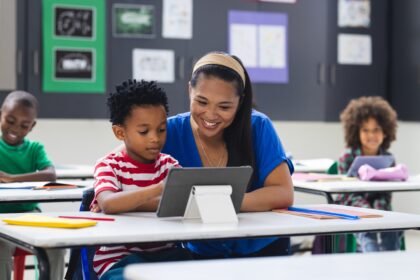The world of education is undergoing a massive transformation, one that is being shaped and redefined by technology. The rapid advancements in digital tools, resources, and platforms have fundamentally altered how we approach learning, both in the classroom and beyond. As we move further into the 21st century, it is clear that the future of education will be deeply intertwined with technology. From Artificial Intelligence (AI) to Virtual Reality (VR), the possibilities for enhancing the educational experience are vast and exciting. But what exactly does the future of learning look like, and how will technology continue to shape it? In this article, we’ll explore the key ways technology is transforming education, the benefits it brings, and the challenges that educators and students alike must face as they adapt to these new paradigms.
1. The Digital Transformation of Education
Technology has fundamentally changed how we access and consume educational content. In the past, students were limited to the textbooks, lectures, and resources available to them in the classroom or library. Now, however, the entire world of knowledge is at their fingertips through the internet. Online courses, digital textbooks, and video tutorials have become commonplace, allowing students to learn anywhere, at any time.
Online Learning and E-Learning Platforms
Platforms like Coursera, edX, Khan Academy, and Udemy have revolutionized how we think about education. These platforms allow students to access high-quality content from top institutions and universities around the world, often for free or at a low cost. As a result, learning is no longer confined to traditional educational institutions. This democratization of knowledge has allowed people from all walks of life and backgrounds to access opportunities that they otherwise might not have had.
In addition, massive open online courses (MOOCs) have become increasingly popular. MOOCs provide flexible, scalable learning opportunities for millions of students across the globe, catering to learners at all levels. These online programs offer certificates or even degrees in various subjects, often without the need for traditional physical attendance.
Blended Learning
Blended learning, which combines traditional classroom teaching with online components, has gained significant traction in schools and universities. By incorporating digital resources into the curriculum, teachers can provide a more flexible and personalized learning experience. Students can access lessons and assignments outside of class time, and class time can be dedicated to interactive discussions, collaborative projects, or problem-solving activities. This approach allows for a more tailored and efficient learning experience, ensuring that students are engaged and active participants in their education.
2. Artificial Intelligence (AI) and Personalized Learning
AI is one of the most exciting technologies shaping the future of education. By utilizing machine learning algorithms and data analytics, AI can help create a more personalized learning experience for students.
Adaptive Learning Platforms
AI-powered adaptive learning platforms are revolutionizing how content is delivered to students. These platforms use data from students’ previous interactions to identify their strengths, weaknesses, and learning preferences. The system then customizes lessons and activities to meet the individual needs of each student. Instead of following a one-size-fits-all approach, adaptive learning ensures that each learner progresses at their own pace and is challenged appropriately based on their abilities.
For example, platforms like DreamBox and Knewton adjust the difficulty level of lessons in real-time, ensuring that students remain engaged and continue to make progress. This level of personalization improves student outcomes and helps them retain information more effectively.
Automated Grading and Feedback
AI is also changing how assessments and feedback are delivered. Automated grading systems, powered by AI, can quickly evaluate assignments, tests, and quizzes, saving educators valuable time and ensuring that students receive immediate feedback. This allows teachers to focus more on providing in-depth explanations and support, rather than spending hours grading assignments.
Moreover, AI can help identify patterns in students’ performance, alerting educators to any areas where students may be struggling. Early intervention is essential for improving educational outcomes, and AI helps provide timely and targeted support to at-risk learners.
3. Virtual Reality (VR) and Augmented Reality (AR) in Education
Virtual Reality (VR) and Augmented Reality (AR) are two other powerful tools that are transforming education. These technologies provide immersive learning experiences that engage students in ways traditional teaching methods cannot.
Immersive Learning with VR
Virtual Reality creates fully immersive digital environments that students can interact with, offering an unprecedented opportunity to explore new concepts in a hands-on, experiential way. For example, students can explore historical landmarks, conduct virtual science experiments, or visit distant planets—all from the comfort of their classrooms. VR makes learning more engaging and interactive, fostering better retention and a deeper understanding of complex subjects.
In medical education, VR allows students to practice surgeries and procedures in a controlled, virtual environment, without the risks associated with real-life practice. Similarly, in fields like architecture and engineering, VR can be used to simulate building designs or factory layouts, allowing students to experiment and refine their skills before applying them in real-world scenarios.
Enhancing Learning with AR
Augmented Reality, on the other hand, overlays digital content onto the real world. This allows students to interact with virtual objects in their physical surroundings. For instance, students studying biology could view 3D models of the human body and interact with organs and systems to better understand their functions. AR can also be used for field trips, allowing students to explore historical events or natural environments through their smartphones or AR glasses.
AR is also being used in K-12 classrooms to bring textbooks and lessons to life. By scanning images in textbooks with a smartphone or tablet, students can unlock additional content, such as videos, animations, or quizzes, providing a more interactive and engaging learning experience.
4. The Role of Data and Analytics in Education
Data analytics plays an increasingly important role in shaping the future of education. By collecting and analyzing data on students’ performance, behavior, and engagement, educational institutions can gain valuable insights that can inform teaching methods and learning experiences.
Tracking Student Progress
Teachers and administrators can use data analytics to track student progress and identify trends in performance. By analyzing test scores, homework submissions, attendance records, and participation in class activities, educators can identify struggling students and provide targeted interventions. This helps to ensure that no student is left behind and that all learners are receiving the support they need to succeed.
Additionally, data-driven insights can inform curriculum design. By analyzing which topics students struggle with the most, schools can adjust their curriculum to focus more on areas where students need additional practice or support. This ensures that the education system remains responsive to the evolving needs of learners.
Predictive Analytics for Personalized Learning
Predictive analytics powered by AI can help identify which students are at risk of falling behind, based on their past performance and behavior. These predictive models can inform interventions that provide students with the right resources at the right time, improving their chances of success. By leveraging big data, educators can personalize learning experiences to meet each student’s individual needs, making education more effective and inclusive.
5. The Future of Teacher-Student Interaction
As technology continues to evolve, the role of teachers will change, but they will remain a central part of the education system. While AI and digital platforms can provide personalized learning and automation, teachers will continue to play an essential role in fostering creativity, critical thinking, and emotional intelligence.
Collaboration Tools
Collaboration tools and digital platforms allow teachers to work together, share resources, and support one another. Platforms like Google Classroom, Microsoft Teams, and Slack enable seamless communication between teachers and students, as well as between teachers and parents. These tools help streamline administrative tasks and ensure that teachers can focus more on teaching and engaging with students.
Human-Centered Learning
Technology should complement, not replace, the human element of learning. Teachers will continue to provide mentorship, emotional support, and motivation to students. They will also guide students in developing essential life skills, such as collaboration, communication, and problem-solving, which are difficult for AI to teach. Technology can provide the tools, but it is the teacher who inspires and nurtures the intellectual and emotional growth of the student.
Challenges and Considerations
While the integration of technology into education brings many benefits, there are also challenges to consider. Not all students have equal access to digital devices and high-speed internet, leading to a growing digital divide. Additionally, there are concerns around data privacy and security, especially as educational institutions collect vast amounts of personal data on students.
Moreover, there is a need for teacher training in the use of new technologies. As the tools and resources available in the classroom evolve, educators must be equipped with the skills to effectively use them to enhance teaching and learning.
Conclusion
The future of learning is undeniably digital, and technology is playing a pivotal role in shaping the education system of the 21st century. From AI-driven personalized learning to immersive experiences in VR and AR, technology is creating new opportunities for students and educators alike. As we continue to embrace these innovations, it’s essential that we ensure equal access to these resources, maintain ethical considerations around data privacy, and provide the necessary training and support for educators to thrive in this new digital landscape.
By harnessing the power of technology, we can create a more inclusive, flexible, and engaging education system that prepares students for success in the increasingly digital world. The future of learning is bright, and it’s only just beginning.
Key Takeaways:
- Technology is transforming education, making it more accessible, flexible, and personalized.
- AI and machine learning are enhancing the learning experience through adaptive learning platforms and automated grading.
- Virtual and augmented reality are providing immersive learning experiences that enhance student engagement and understanding.
- Data analytics plays a crucial role in tracking student progress and informing teaching methods.
- Teachers will continue to be central to the educational experience, offering mentorship and guidance in an increasingly digital world.





